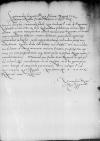List #2218
Sigismund I Jagiellon do Ioannes DANTISCUS & Tiedemann GIESECracow (Kraków), 1539-08-20
| odebrano 1539-12-11 Rękopiśmienne podstawy źródłowe:
Publikacje:
| ||||||||
Tekst + aparat krytyczny + komentarz Zwykły tekst Tekst + komentarz Tekst + aparat krytyczny
Reverendis in Christo Patribus, dominis
Reverendi in Christo Patres, sincere nobis dilecti.
Quae cf.
cf.
Bene valeant Paternitates Vestrae.
Dat(ae) or Dat(um)⌈Dat(ae)Dat(ae) or Dat(um)⌉
Ad mandatum regiae maiestatis proprium


 BCz, 1601, p. 328
BCz, 1601, p. 328